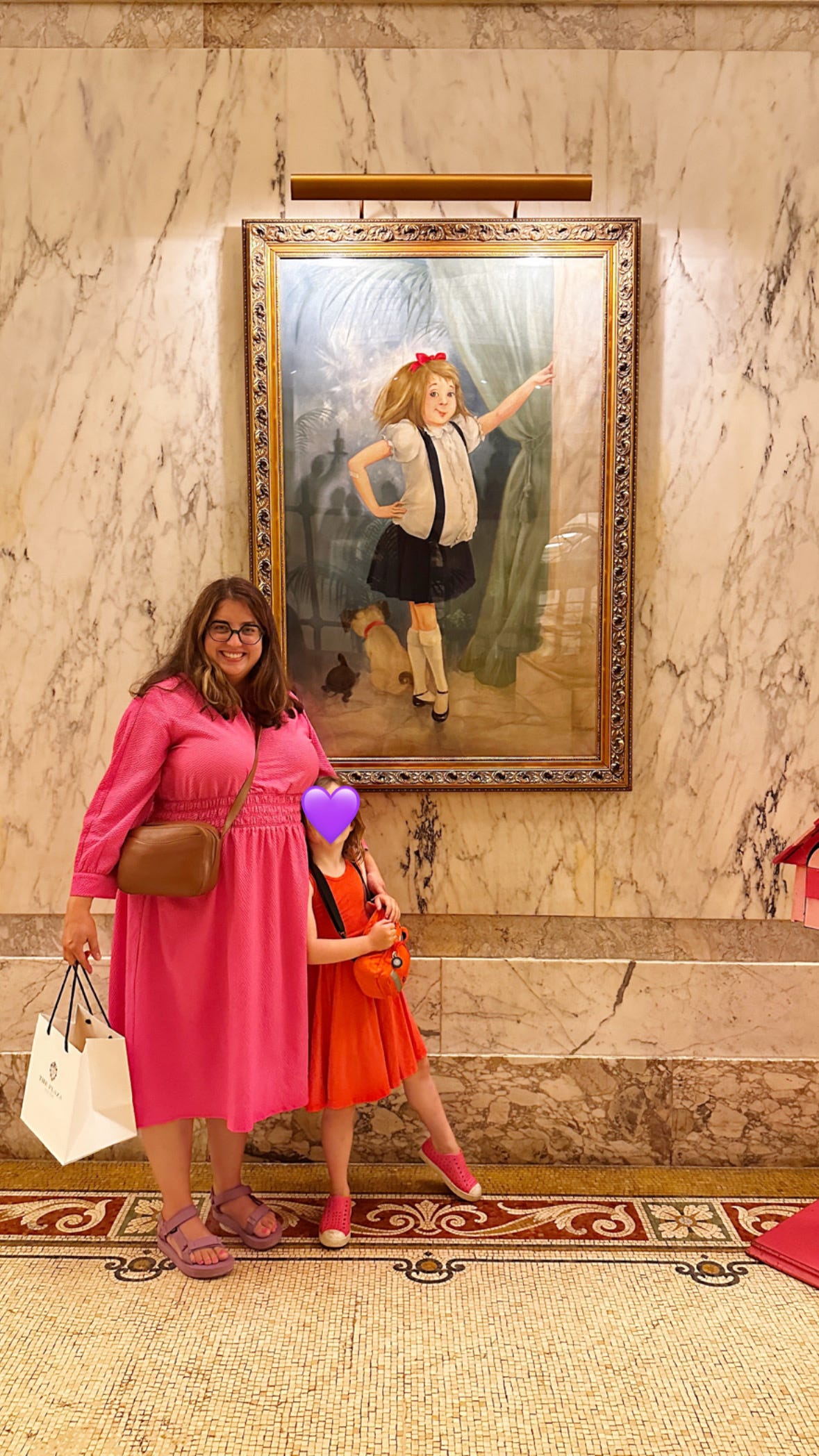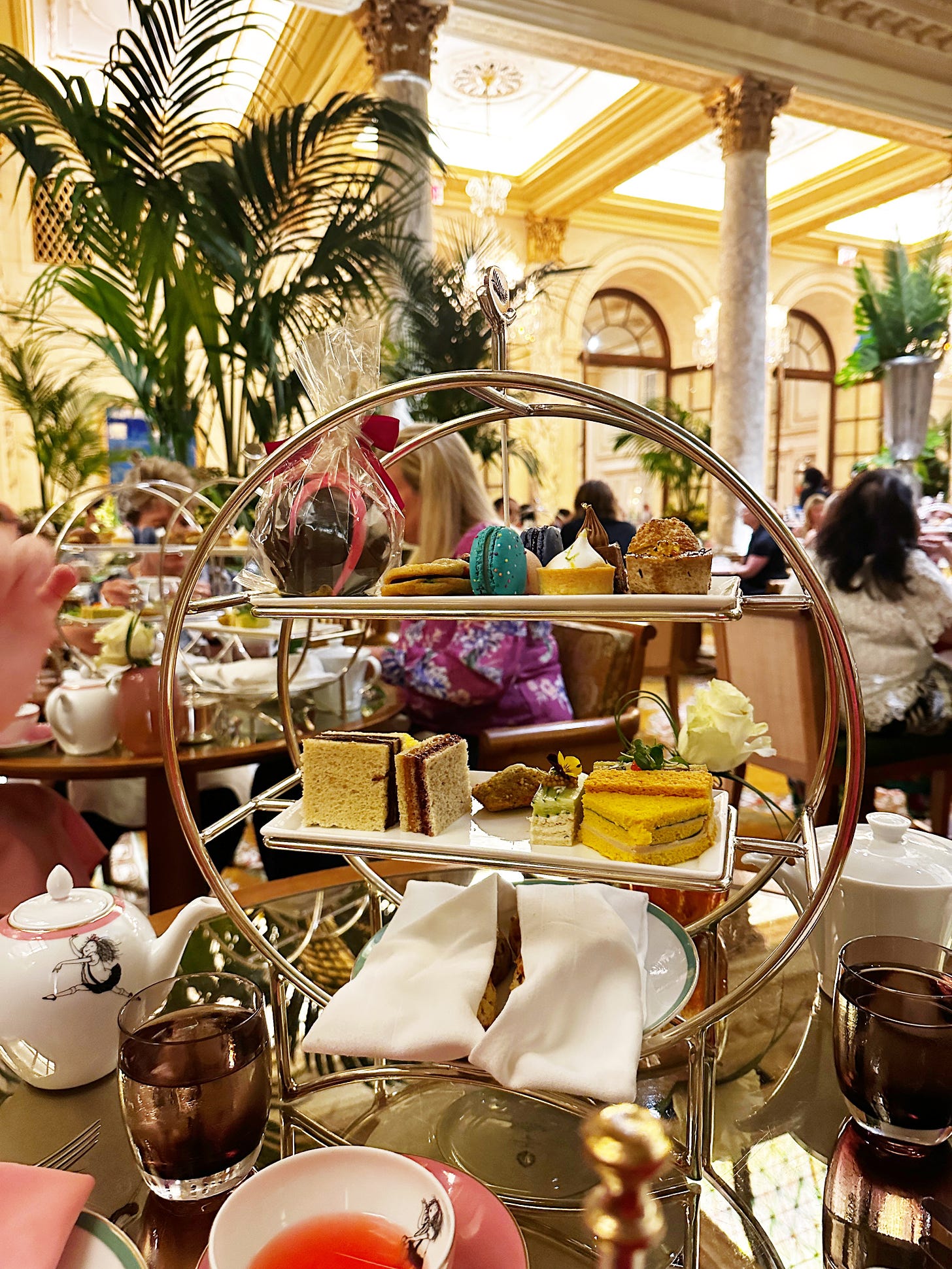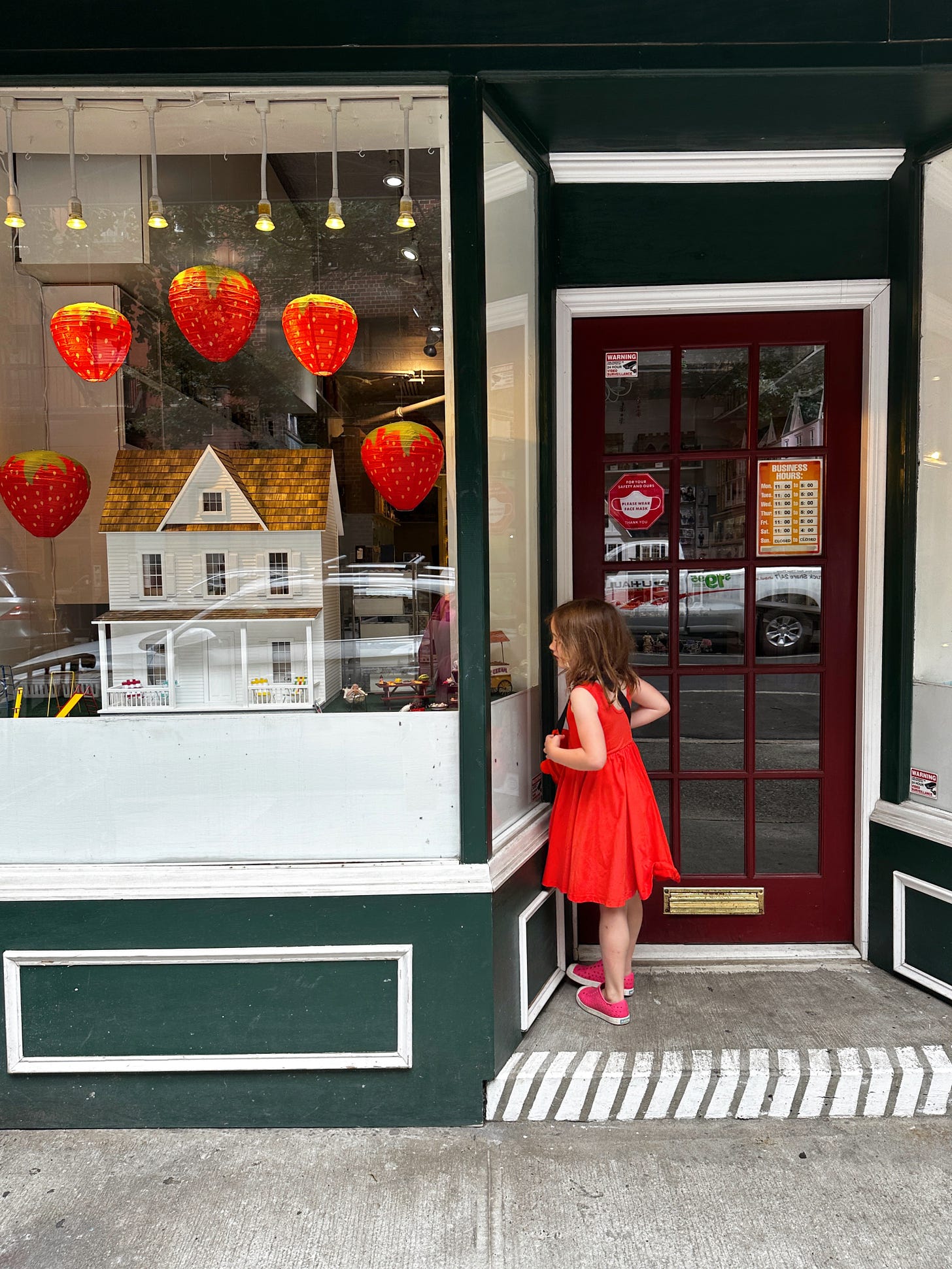So I haven’t see the Barbie movie yet (but my nine-year-old went and reviewed it as “actually pretty good!”) soI don’t have a topical think piece for you yet. (Here’s the last time I wrote about Barbie though.) But last weekend, while her big sister was away at sleep away camp, I took my almost-six-year-old to New York City. We rode the subway, ate ice cream, and visited a magical dollhouse store (more on that below). But the raison d’etre for the entire trip was afternoon tea at The Plaza.
We’ve been planning to do this for months and months, ever since Beatrix first fell in love with Eloise, the iconic picture book by Kay Thompson. This Eloise phase is no accident. I planted the book for her, just as I did (with much less success) for her older sister around the same age because I remember reading Eloise, first with my dad and then on my own, over and over as a kid. The best part, by far, is the elevator page which folds open so you can trace Eloise’s path as she rides up and down, skibbling down the stairs to catch the same elevator she’s just vacated, and thoroughly confusing the hotel staff and other guests.
As a mom, I’ve sometimes regretted introducing Eloise because it turns out to be an absolutely exhausting bedtime read (that elevator page takes forever! There is a freaking song break midway through, which I try to skip but often am not allowed!). This makes sense because Kay Thompson was a cabaret singer (and radio star, actress, dancer, vocal coach and arranger) who never intended to write a children’s book, never had kids or seemed to like them much, and presumably never read anyone a bedtime story in her life.1 She remained clear until she died that Eloise wasn’t a kid’s book at all.
Nevertheless, millions of kids love Eloise because she is a feral child with unbrushed hair and no adult supervision, running wild in a fancy hotel where the adults always seem to give in and do whatever she says. She is the proto-Kevin McCallister, smarter and more creative than Dennis the Menace or Bart Simpson, and most importantly, a girl who has the kinds of adventures that way too many children’s books still reserve only for boys or talking animals. So off we went to The Plaza to see the famous painting and have tea in The Palm Court, just like Eloise does when it’s raining, and to maybe catch a glimpse of our Eloise, sklonking her skates along the marble halls and shaking down the mailroom guys for a present.
What we found: An Eloise gift shop, selling Eloise pajamas and key chains and dolls and hot pink bean bag chairs. A $3500 Eloise Suite that I absolutely did not book (nor tell Beatrix of its existence). And the Eloise Tea —pink lemonade served in an Eloise teapot plus a teensy handful of doll-sized crustless sandwiches and cookies for $90 per child at the Palm Court— which I did.
What we did not find: Eloise. The Eloise that The Plaza sells now is more like an unofficial brand extension of American Girl dolls meets Barbie, pre-Greta Gerwig plus a splash of momfluencer. And it’s a version of American girlhood that I’m not sure Kay Thompson would appreciate. Every mother/daughter pair in the Palm Court (and that is almost exclusively who eats at the Palm Court) had their hair brushed, if not also blown out and barrel-curled. Matching Christy Dawn or Lily Pulitzer dresses were in abundance. A few even had hats and gloves. Little girls perched carefully on their chairs, napkins on laps, picking adorable macaroons off the top level of their Eloise tea towers. Nobody skibbled or sklonked. Nobody wore an egg cup as a hat.
By eavesdropping madly, I deduced that some mothers and daughters make the Palm Court a semi-regular tradition a la Carmela and Meadow Soprano. At the table next to us, I watched a grandmother, mother, and white sundress-clad teenage daughter, all blond, all thin, all immaculate, idly discuss their caviar until the mother leaned in: “Okay, we’ve lured you here with tea,” she said. “Now do you have any boyfriend updates for us?” The daughter slumped into the banquette. “There are a few people,” she said carefully, and I wondered if the gender neutral choice was intentional.
Mostly, I wondered why we were all paying so much money for such tiny portions of food. Although the tea menu boasts an elaborate list of sandwiches and cakes, the reality was roughly six bites of food per person. Maybe nobody else goes to afternoon tea expecting a full meal, even when it costs more than most date nights, but I was hoping for lunch not Girl Dinner on a diet. The sandwiches tasted like they’d been made days ago in the basement of a Pret A Manger. Every meat was presented in paste form. Everything tasted vaguely sugar-coated and also like nothing at all, even when it was allegedly a chicken sandwich. It seems wild that The Plaza can get away with serving such awful food until you remember that mostly only women and children eat here. The sole men in the whole restaurant were a couple of bored-looking grandpas there to foot the bill, and the waiters who haul the tea towers around, dropping them off at tables and darting away as quickly as possible. Nobody is there to eat. We are there to play tea party.

It’s not that Kay Thompson wouldn’t immediately recognize this performance of femininity. She’s also famous for playing the imperious fashion magazine editor in “Funny Face” who sings “Think Pink,” and worked in Hollywood for decades, where she wasn’t considered pretty enough for on-camera work but found massive success as a vocal coach for stars like Judy Garland, Lena Horne and Rita Hayworth. She reportedly lived on Fig Newtons, Coca-Cola and vitamin B-12 shots that later turned out to be “mostly speed,” and when I listened to The Best of Kay Thompson on Spotify, I was not surprised to hear an adherence to beauty ideals and anti-fatness woven throughout. (It’s still really fun music to cook dinner to.)

Thompson also struggled with a drug addiction, often spoke in Eloise’s voice and insisted they were the same person. Reports vary as to whether Eloise was just a cabaret bit, an imaginary friend from her childhood, or if she later descended into some kind of Grey Gardens-style “I am Eloise” psychosis. There are rumors that Thompson stole and destroyed The Plaza’s portrait of Eloise in 1960, as a stunt. She shut down production on the Eloise empire at the height of its early success, seemingly on a whim. And yet—Thompson was also a shrewd business person who was the first cabaret singer to crack the million dollar ceiling and launched a successful clothing line, while also managing to live rent-free in The Plaza for years. Every media report I can find on Thompson labels her as “difficult” and “a scenery-chewing diva,” but come on. If Thompson were a man, we would just remember her as an eccentric genius.
Thompson’s world was undeniably white, WASP-y, and privileged, but she knew that was a house of cards. She was born Kitty Fink, daughter of a Jewish Austrian immigrant, and changed her name when she launched her showbiz career; her biographer also reports that she had the first of five nose jobs at age 18 and lied about her age until her death at either 88 or 95. All of which sounds like the heartbreakingly logical survival strategy of a woman told by powerful white men throughout her career that she had “a face for radio.”
And yet, she kept looking for ways to blow it all up, or at least pour a pitcher of water down the mail shoot and gum up the works. The magic of Eloise is in how matter of factly Eloise names all of this darkness. Her parents are absent; her father is never mentioned at all, and her mother “is 30 and has a charge account at Bergdorf’s.” There are no matching Christy Dawn dresses (or the 1950s equivalent) because Eloise’s mother can only be reached via long distance phone calls and is often traveling with random men who are “absolutely so dumb” and bring Eloise presents. Eloise spends most of her time with Nanny, a British babysitter who looks proper and wears corsets, but loves to smoke and drink three Pilsner beers on fight nights. Everything pretty or perfect in Eloise’s world is also just a little bit askew. Or a lot: In the original draft of her fourth Eloise book, Eloise Takes A Bawth, Thompson ended the story with The Plaza flooding and everyone dying. (It was published posthumously with a different ending.)
There is something prescient in that original ending. The Plaza hasn’t flooded, but it was bought by Donald Trump in 1988 (he tried to get Thompson to bring back Eloise then; she turned him down #icon). He ran it into bankruptcy, then lost $83 million selling it to foreign investment groups and it’s changed hands every few years since. The Plaza today still unapologetically starts room rates at $900 per night but it’s banking hard on nostalgia over substance. And on the willingness of women to pay steak dinner prices for two square inches of cucumber layered atop what the menu describes as “Labneh With Mint, Lemon Zest, Tarragon, Pickled Mustard Seeds,” but tastes only of stale white bread plus a smidge of mayo.
Beatrix and I tried nibbles of everything, but ultimately gave up on considering our tea a meal. The waiter, rightly concerned about the money I was wasting on this experience, brought a box for our leftover doll sandwiches and cakes, and I pulled them out again later in our much cheaper hotel room a few blocks away. We ate the best of the little cakes then, alongside heaping room service orders of French fries and spaghetti (plus a Nanny-would-approve glass of Malbec for me), while watching “Encanto” in bed, and then fell asleep in sheets streaked with ketchup.
“She is not yet pretty,” Thompson once wrote of her character/alter ego. “But she is already a Person.” At The Plaza, Eloise is only pretty now. We left her there.
What Else Did We Do in NYC?
Since we live close enough to NYC to day trip often, I didn’t worry about hitting any exhaustive list of major sights or covering a ton of ground on this visit. But here are a few other fun things we did on our weekend, in case you are also contemplating a NYC trip with an almost-6-year-old or thereabouts…






